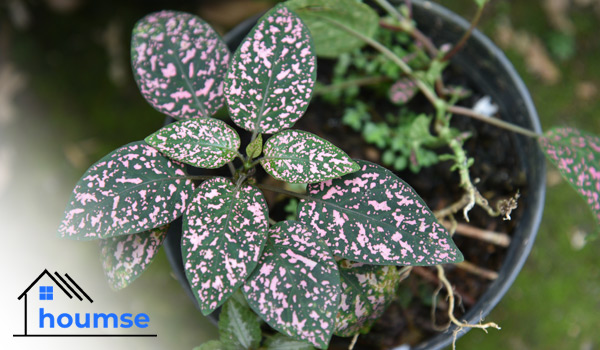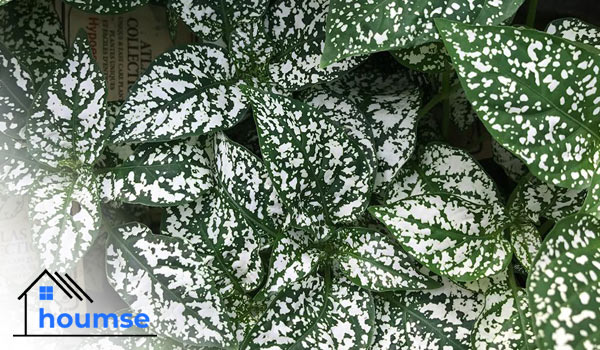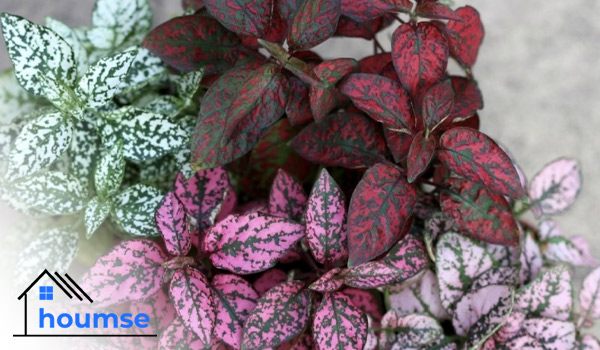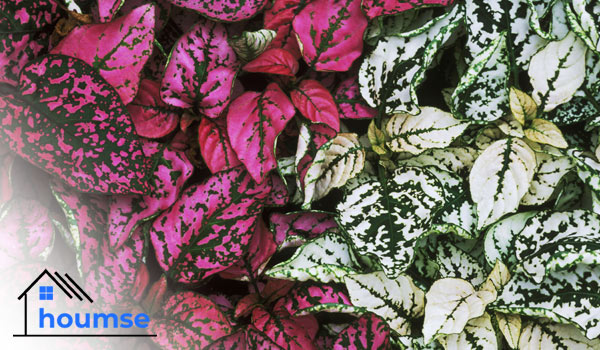Polka Dot Plant Care Indoor (Hypoestes Guide)

Native to South Africa, East Asia, and Madagascar, the polka dot plant can grow up to 3 ft tall and wide. This evergreen shrub is widely known for its green leaves marked with white or pink spots, depending on the variety.
When grown outside, the polka dot plant is a perennial, and it becomes woody and spindly as it ages. However, you can grow it indoors as a houseplant too. It will be smaller yet incredibly charming thanks to the beautiful hypoestes plant’s foliage and the interesting contrast it creates with other plants in your collection.
Hypoestes Plant Info
This is the polka dot plant at a glance.
Now, let us take a closer look at this impressive species. In terms of appearance, hypoestes is a common houseplant coveted for its unique foliage.
There are many different varieties of this plant with pink and green leaves, and depending on that, it can also display shades of white, green, or yellow spots in addition to pink. Also known as the freckle face plant, some varieties even have multiple shades on a single plant.
Many people grow their pink polka dot plant in a grouping of indoor colored houseplants for excellent contrast, while others use it as the centerpiece in a group of plants in a large window box.
Regardless of your preferred scenario, when growing your hypoestes with other plants, keep the species that have similar water and moisture close to each other to ensure they get enough water.

Polka Dot Plant Flowers
Gorgeous foliage with white, pink, green, or yellow spots is not all that the hypoestes plant has to offer, there are also lovely, brightly colored flowers. Because of this, it is an ideal plant to place among other plantations to get a beautiful display of colors too.
Polka dot plant also produces seeds under ideal conditions. Seeds will germinate easily in a warm, moist potting mix when the temperature is 70-75°F.
Hypoestes Plant Toxicity
Fortunately, hypoestes phyllostachya is not toxic to animals or humans, so it can be grown in every home without precautions.
Polka Dot Plant Life Span
Next to all its benefits (aesthetics, air filtration, and removing toxins), unfortunately, the polka dot plant’s life span is not long, even when compared to other houseplants.
You can enjoy growing hypoestes plants for about two years, they will deteriorate after blooming and you cannot prevent it. Although there are tips to postpone it, we will discuss them in the polka dot plant care part, the ‘pruning’ section.

Polka Dot Plant Care Indoors
In its native habitat, South Africa, East Asia, and Madagascar, the plant is frequently grown outdoors. When grown outdoors, it can grow more than 3 ft in height. However, it is well suited to indoor life and makes a lovely addition to any corner, shelve, or houseplant collection.
To have a healthy plant with pink and green leaves that brighten up any space, keep these tips in mind:
Light
Bright, indirect light is ideal for hypoestes care. Such condition will keep the colors of the plant vibrant while also preventing it from becoming spindly and leggy. If you grow the plant in a location with low light, it will grow quickly and lose its color. A spot with too bright light will also fade the foliage.
If you aim for a brightly colored pink polka dot plant, we recommend placing it in a dimly lit location of the house. However, keep in mind that if you place it in a spot with low light, it can become skinny and wiry, so you will need to pinch it frequently to ensure it stays strong and healthy.
For the best results in polka dot plant care, place the plant several feet from a south window or east-facing window. You can also grow your hypoestes using grow lights that offer a full spectrum.
Watering
This species requires moist but not soggy soil. So, if the soil dries out for too long, you can expect it to shrivel and sag. However, fortunately, a quick watering usually helps the plant to recover. Also, avoid letting your lovely plant with pink and green leaves sit in water as it will lead to root rot.
Water well when the top ½ to 1 inch of soil is dried. Keep in mind that smaller pots dry out more quickly than larger ones. Make sure you water the plant at the stem without pouring the water all over its leaves and stem to prevent damage to tender leaves and flowers.
Soil and Fertilizer
In polka dot plant care, you need to provide it with rich, moist soil. An organic potting soil that drains well is excellent. Make sure that if the potting soil is not rich, add some compost materials to the soil and combine it well before planting your hypoestes.
This pink and green plant appreciates regular feeding too. It is recommended to fertilize it about once a month with an organic houseplant fertilizer designed for indoor plants.
Temperature and Humidity
Polka dot plant thrives when the temperature is around 75°F. It requires well-drained soil and should not be in a room where the temperature drops below 60 °F.
It also prefers high humidity and will benefit from misting a couple of times a day. You can also place your pink leaf plant in a humidity tray (a tray with pebbles and water with the plant placed on them will work well as a humidity tray).
Polka Dot Plant Care Outdoor Tip
As a tropical plant, hypoestes will not survive frosty weather. So, in case of growing outdoors in the garden, you can cut stems from the plant before the first frost, and root them indoors in a container or water.
If kept outdoors in a container, bring it indoors and place it in a partially sunny spot. In the spring, after the frost, you can replant it in the garden after.
Pruning
Since this adorable plant with pink and green leaves tend to get leggy, it is recommended to consider pruning in polka dot plant care as well.
To prevent your plant from developing long, slender branches (and encouraging a bushier, healthier, and more vigorous growth habit), cut or pinch the top two leaves on each stem using e pruning shears or a pair of clean, sharp scissors every week.
We know polka dot plant flowers sound and look nice, but it is best to clip them when they start appearing to extend the growing season of your hypoestes plant. Do not worry, the leaves are far more ornamental than the blooms. The plant will perish or become dormant when flowering is finished.
Common Pests and Diseases
This eye-catching pink and green plant is susceptible to whitefly, mealybug, and aphids. If noticed any of these pests, use a medium-strength soap and water solution to wipe them from the leaves.
In addition, as mentioned, overwatering any type of pink leaf plant will lead to root rot. You may also notice the presence of powdery mildew on the plant. Reduce irrigation to resolve the problem.

Polka Dot Plant Varieties
Polka dot plant belongs to the Hypoestes Phyllostachya species with more than 100 varieties, and you can always find several of them at garden centers. You can choose from a wide variety of pink and green plants, and these are the more common types:
- Carmina: This type features bright red spots on green foliage.
- Confetti: These are smaller plants that grow to around 8 inches in size. They are very vigorous and grow quickly. Confetti has five different color options: white, red, pink, carmine-pink, and an amazing burgundy red hue.
- Pink Brocade: This polka dot plant features mottles pink spots on green leaves.
- Pink-dot: As its name suggests, this hypoestes plant variety boasts pink dots on the green leaves with a sparse distribution.
- Purpariana: This is no regular plant with pink and green leaves, this type actually has a purple hue to its leaves.
- Splash Series: This variety features oversized patches of contrasting pinks, roses, whites, and reds.
Breeders and gardeners are always creating new varieties. Some have speckled green spots and others have spots with various shades that make them unique. From purple to lavender to scarlet to white, there is a color to suit every décor.
Among polka dot plant varieties, Confetti has one of the most unique colorations with spots scattered sparsely on green foliage. Whichever type you choose; it will perform very well as a houseplant and brighten up your space and mood for multiple years.

Polka Dot Plant Propagation
Similar to polka dot plant care, growing these plants requires minimum effort too. You can easily germinate the seeds in a moist potting medium at 70 to 75 degrees Fahrenheit.
You can also grow hypoestes from cuttings. To do this, simply remove a terminal bud at a node (make a cut from the tip of one of the stems about four to five inches in length) and remove the leaves at the end of the cutting.
Although you can dip the cutting end in root hormone, this is not usually necessary for growing this pink and green plant, as it will root in water or a coarse potting mix, such as cactus mix. If planted in a coarse potting mix, keep the cutting potting media moist. It should take root in a few days
When the roots appear and reach 3-5 inches in length, plant the cutting in rich, moist potting soil and you have a brand-new plant! You can use polka dot plant care mentioned earlier to care for it.
Hypoestes plants are easy to grow both indoors in a small to a medium pot and outdoors in plantings. Your polka dot plant loves sunlight, but too much sunlight will cause it to fade. So, make sure to find a spot with a healthy amount of sunlight for the best results.
- In this post:
- Hypoestes Plant Info
- Polka Dot Plant Care Indoors
- Polka Dot Plant Varieties
- Polka Dot Plant Propagation



